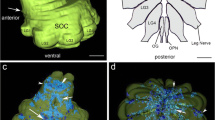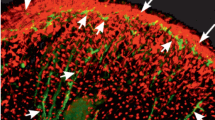Abstract
FMRFamide-related proteins have been described in both vertebrate and invertebrate nervous systems and have been suggested to play important roles in a variety of physiological processes. One proposed function is the modulation of signal transduction in mechanosensory neurons and their associated behavioral pathways in the Central American wandering spider Cupiennius salei; however, little is known about the distribution and abundance of FMRFamide-related proteins (FaRPs) within this invertebrate system. We employ immunohistochemistry, Hoechst nuclear stain and confocal microscopy of serial sections to detect, characterize and quantify FMRFamide-like immunoreactive neurons throughout all ganglia of the spider brain and along leg muscle. Within the different ganglia, between 3.4 and 12.6% of neurons showed immunolabeling. Among the immunoreactive cells, weakly and strongly labeled neurons could be distinguished. Between 71.4 and 81.7% of labeled neurons showed weak labeling, with 18.3 to 28.6% displaying strong labeling intensity. Among the weakly labeled neurons were characteristic motor neurons that have previously been shown to express ɣ-aminobutyric acid or glutamate. Ultrastructural investigations of neuromuscular junctions revealed mixed presynaptic vesicle populations including large electron-dense vesicles characteristic of neuropeptides. Double labeling for glutamate and FaRPs indicated that a subpopulation of neurons may co-express both neuroactive compounds. Our findings suggest that FaRPs are expressed throughout all ganglia and that different neurons have different expression levels. We conclude that FaRPs are likely utilized as neuromodulators in roughly 8% of neurons in the spider nervous system and that the main transmitter in a subpopulation of these neurons is likely glutamate.









Similar content being viewed by others
References
Babu KS, Barth FG (1984) Neuroanatomy of the central nervous system of the wandering spider, Cupiennius salei (Arachnida, Araneida). Zoomorphol 104:344–359
Barth FG, Libera W (1970) Ein Atlas der Spaltsinnesorgane von Cupiennius salei Keys. Chelicerata (Araneae). Z Morph Ökol Tiere 68:343–369
Becherer C, Schmid A (1999) Distribution of ɣ-aminobutyruc acid-, proctolin-, Periplaneta hypertrehalosaemic hormone- and FMRF-amide-like immunoreactiviy in the visual ganglia of the spider Cupiennius salei Keys. Comp Biochem Physiol 122:267–275
Boarder MR (1989) Presynaptic aspects of cotransmission: relationship between vesicles and neurotransmitters. J Neurochem 53:1–11
Church PJ, Lloyd PE (1991) Expression of diverse neuropeptide cotransmitters by identified motor neurons in Aplysia. J Neurosci 11:618–625
Civelli O (2012) Orphan GPCRs and neuromodulation. Neuron 76:12–21
Croset, V., Treiber, C. D., and Waddell, S. (2017). Cellular diversity in the Drosophila midbrain revealed by single-cell transcriptomics. bioRxiv. https://doi.org/10.1101/237818 [preprint]. Now in eLife
Fabian R, Seyfarth EA (1997) Acetylcholine and histamine are transmitter candidates in identifiable mechanosensitive neurons of the spider Cupiennius salei: an immunocytochemical study. Cell Tissue Res 287:413–423
Fabian-Fine R, Anderson CM, Roush MA, Johnson JAG, Liu H, French AS, Torkkeli PH (2017) The distribution of cholinergic neurons and their co-localization with FMRFamide, in central and peripheral neurons of the spider Cupiennius salei. Cell Tissue Res 370:71–88
Fabian-Fine R, Volknandt W, Seyfarth E (1999a) Peripheral synapses at identifiable mechanosensory neurons in the spider Cupiennius salei: synapsin-like immunoreactivity. Cell Tissue Res 295:13–19
Fabian-Fine R, Hoger U, Seyfarth EA, Meinertzhagen IA (1999b) Peripheral synapses at identified mechanosensory neurons in spiders: three-dimensional reconstruction and GABA immunocytochemistry. J Neurosci 19:298–310
Fabian-Fine R, Meinertzhagen IA, Seyfarth EA (2000) Organization of efferent peripheral synapses at mechanosensory neurons in spiders. J Comp Neurol 420:195–210
Fabian-Fine R, Meisner S, Torkkeli PH, Meinertzhagen IA (2015) Co-localization of gamma-aminobutyric acid and glutamate in neurons of the spider central nervous system. Cell Tissue Res 362:461–479
Foelix RF, Chu-Wang IW (1973) The morphology of spider sensilla. I. Mechanoreceptors. Tissue & Cell 5:451–460
Jan LY, Jan YN (1982) Peptidergic transmission in sympathetic ganglia of the frog. J Physiol 327:219–246
Kolodziejczyk A, Sun X, Meinertzhagen IA, Nässel DR (2008) Glutamate, GABA and acetylcholine signaling components in the lamina of the Drosophila visual system. PLoS One 3:e2110. https://doi.org/10.1371/journal.pone.0002110
Lingueglia E, Champigny G, Lazdunski M, Barbry P (1995) Cloning of the amiloride-sensitive FMRFamide peptide-gated sodium channel. Nature 378:730–733
Lee JS, Shih PY, Schaedel ON, Quintero-Cadena P, Rogers AK, Sternberg PW (2017) FMRFamide-like peptides expand the behavioral repertoire of a densely connected nervous system. Proc Natl Acad Sci U S A 114:E10726–E10735
Liu X, Porteous R, d’Anglemont de Tassigny X, Colledge WH, Millar R, Petersen SL, Herbison AE (2011) Frequency-dependent recruitment of fast amino acid and slow neuropeptide neurotransmitter release controls gonadotropin-releasing hormone neuron excitability. J Neurosci 31:2421–2430
Loi PK, Tublitz NJ (2000) Roles of glutamate and FMRFamide-related peptides at the chromatophore neuromuscular junction in the cuttlefish, Sepia officinalis. J Comp Neurol 420:499–511
Merighi A, Salio C, Ferrini F, Lossi L (2011) Neuromodulatory function of neuropeptides in the normal CNS. J Chem Neuroanat 42:276–287
Nässel DR (2018) Substrates for neuronal cotransmission with neuropeptides and small molecule neurotransmitters in Drosophila. Front Cell Neurosci 12(83)
Nusbaum MP, Blitz DM, Marder E (2017) Functional consequences of neuropeptide and small-molecule co-transmission. Nat Rev Neurosci 18:389–403
Panek I, French AS, Seyfarth EA, Sekizawa S, Torkkeli PH (2002) Peripheral GABAergic inhibition of spider mechanosensory afferents. Eur J Neurosci 16:96–104
Panek I, Torkkeli PH (2005) Inhibitory glutamate receptors in spider peripheral mechanosensory neurons. Eur J Neurosci 22:636–646
Pfeiffer K, Panek I, Hoger U, French AS, Torkkeli PH (2009) Random stimulation of spider mechanosensory neurons reveals long-lasting excitation by GABA and muscimol. J Neurophysiol 101:54–66
Rabbitt RD, Brownell WE (2011) Efferent modulation of hair cell function. Current Opinion Otolaryngology Head Neck Surgery 19:376–381
Salio C, Lossi L, Ferrini F, Merighi A (2006) Neuropeptides as synaptic transmitters. Cell Tissue Res 326:583–598
Schmid A, Dunker M (1993) Histamine immunoreactivity in the central nervous system of the spider Cupiennius salei. Cell Tiss Res 273:533–545
Schrott-Fischer A, Kammen-Jolly K, Scholtz A, Rask-Andersen H, Glueckert R, Eybalin M (2007) Efferent neurotransmitters in the human cochlea and vestibule. Acta Otolaryngol 127:13–19
Schwarzer C, Sperk G (1995) Hippocampal granule cells express glutamic acid decarboxylase-67 after limbic seizures in the rat. Neuroscience 69:705–709
Seyfarth EA, Hammer K, Sporhase-Eichmann U, Horner M, Vullings HG (1993) Octopamine immunoreactive neurons in the fused central nervous system of spiders. Brain Res 611:197–206
Seyfarth EA, French AS (1994) Intracellular characterization of identified sensory cells in a new spider mechanoreceptor preparation. J Neurophysiol 71:1422–1427
Skerrett M, Peaire A, Quigley P, Mercier A (1995) Physiological effects of two FMRFamide-related peptides from the crayfish Procambarus clarkii. J Exp Biol 198:109–116
Sloviter RS, Dichter MA, Rachinsky TL, Dean E, Goodman JH, Sollas AL, Martin DL (1996) Basal expression and induction of glutamate decarboxylase and GABA in excitatory granule cells of the rat and monkey hippocampal dentate gyrus. J Comp Neurol 373:593–618
Suggs JM, Jones TH, Murphree SC, Hillyer JF (2016) CCAP and FMRFamide-like peptides accelerate the contraction rate of the antennal accessory pulsatile organs (auxiliary hearts) of mosquitoes. J Exp Biol 219:2388–2395
Tritsch NX, Ding JB, Sabatini BL (2012) Dopaminergic neurons inhibit striatal output through non-canonical release of GABA. Nature 490:262–266
Trudeau LE (2004) Glutamate co-transmission as an emerging concept in monoamine neuron function. J Psychiatry Neuroscience : JPN 29:296–310
van den Pol AN (2012) Neuropeptide transmission in brain circuits. Neuron 76:98–115
Whim MD, Lloyd PE (1989) Frequency-dependent release of peptide cotransmitters from identified cholinergic motor neurons in Aplysia. Proc Natl Acad Sci U S A 86:9034–9038
Widmer A, Hoger U, Meisner S, French AS, Torkkeli PH (2005) Spider peripheral mechanosensory neurons are directly innervated and modulated by octopaminergic efferents. J Neurosci 25:1588–1598
Acknowledgements
Confocal imaging was performed at the University of Vermont Microscopy Imaging Center. The authors thank Dr. Douglas Taatjes, Nicole Bouffard and Nicole Bishop for continued support with confocal microscopy. We thank Duy Pham of Colchester High School/Vermont for the artwork in Fig. 1(a). Its contents are solely the responsibility of the authors and do not necessarily represent the official views of NIGMS or NIH.
Funding
The Zeiss 510 META laser scanning confocal microscope was supported by NIH Award Number 1S10RR019246 from the National Center for Research Resources. The Alden Foundation supported the purchase of essential equipment for the SMC Biology Department. KG and BF received generous research stipends from Mr. Michael J. Cunniff and Dr. Robert F. Tobin. This research was supported by an Institutional Development Award (IDeA) from the National Institute of General Medical Sciences of the National Institutes of Health under grant number P20GM103449 (RF-F, BF, ET, KC, CA, KG and AJ). Further support was received in the form of a research stipend from The John C Hartnett fund to NG.
Author information
Authors and Affiliations
Corresponding author
Rights and permissions
About this article
Cite this article
Tarr, E.A., Fidler, B.M., Gee, K.E. et al. Distribution of FMRFamide-related peptides and co-localization with glutamate in Cupiennius salei, an invertebrate model system. Cell Tissue Res 376, 83–96 (2019). https://doi.org/10.1007/s00441-018-2949-0
Received:
Accepted:
Published:
Issue Date:
DOI: https://doi.org/10.1007/s00441-018-2949-0




